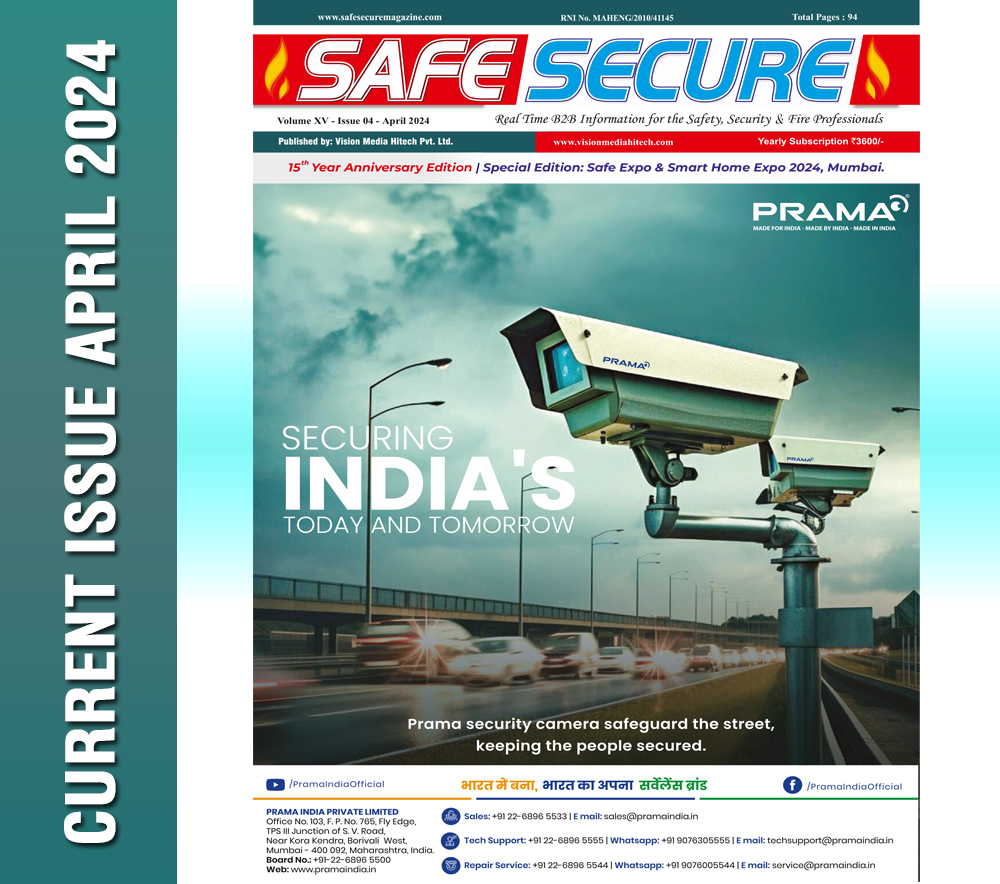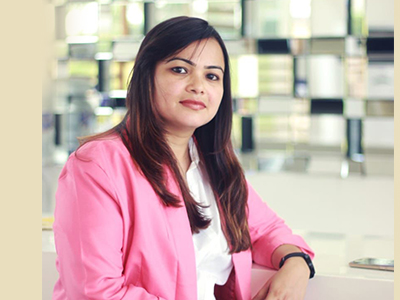Be it guarding a site, overseeing operations inside a command-and-control center, detailing use cases, developing world class products or validating technology - women professionals are doing an excellent job. I would love to see more women take up security as a profession

Ms. Rashmi Bhangale has 22 years of rich industry experience working for Reliance - India's largest private sector Fortune 500 company. As Asst. Vice President & Head PMO – Security Technology Platform, she is responsible for driving complex projects including Drones, Counter Drones, Integrated Operations Centres, and Perimeter Security, among others. She has experience in defining problem statements, solution engineering & design, validating systems and their deployment across several RIL assets spread across diverse geographies. Ms. Rashmi is well-published in reputed platforms and conferences. Her latest paper published at World Economic Forum focusses on the role of drones in performing Oil and Gas pipelines maintenance.
Q. How is technology reshaping the security sector in India?
Thanks for this opportunity. To address your question, we frst need to understand the nature and type of threats faced by security industry.The nature of threats has become complex. Security industry is constantly brainstorming on how to meet these evolving challenges. Adversaries are innovating fast and using wide array of technologies & methodologies to present threats which could be detrimental.
Technology has always played a crucial role in addressing security challenges. However, we need to now make integrated use of technology and adopt a multi-disciplinary approach to tackle emerging threats. We are now in the era of data driven decision making. Security industry is now integrating data generated from multiple systems and sensors to provide a common operating picture for effective security management.
Q. With initiatives like Make in India, as encouragement to manufactures, how far do you see the manufacturing abilities of India will take us on the Export –Import map? how do you see it beneftting security industry?
Make in India is an interesting concept and must be seen in totality, rather than merely from a sectoral perspective. By this I mean that advances achieved in multiple sectors such as defence, electronics, aviation, space, electrical machinery, etc. will have a positive impact on defence & security industry.
And why just talk about Make in India. There are several other visionary policy initiatives by Government which will support innovation and indigenous manufacturing.
Take for instance the PLI scheme to support indigenous manufacturing of drones and drone components. Similarly, many start-ups are being groomed under policy initiatives such as Startup India, MEITY Startup Hub and the iDEX (Innovations for Defence Excellence) initiative of the Ministry of Defence to name a few. In a few years' time, India will become a hub for several world class defence and security products which will cater to domestic & foreign customers. As an industry, it is heartening to see the Government's vision to achieve an export target of USD 5 billion in defence by 2025. Security industry too will beneft substantially from the efforts that will go into achieving this aim.
Innovators and end-users need to collaborate closely to develop products & solutions which are industry relevant. Vendors will have to understand that their niche technology should be able to respond to specific use cases and demonstrate value to meet the operational expectations of end users. It will also help improve their product development efforts signifcantly and also plan future product roll outs that are market relevant.
Q. The security industry has become a high-tech, dynamic world to operate in. What new and exciting things can we expect to see over the next decade from the industry? Future plans.
There are so many things to talk about in terms of what can be expected from this industry. Before we talk about technology, let's try to understand the range of assets that security industry is expected to protect. Manufacturing sites, power plants, pipelines, retail stores, data centers, onshore and offshore energy installations, mining sites, dams, business districts, industrial zones and office campuses are just a few examples of type of assets that security professionals are expected to safeguard. The type of assets also define the types of technologies to be deployed. So, to answer your question, let me focus on a few game changing trends which are bound to play a key role over the next decade.
Drones: To begin with, I forsee a larger & expanded role of drones in addressing several security functions of a site. Be it a critical infrastructure, oil & gas pipelines, a manufacturing site or a power plant - drones are expected to play a pivotal role in addressing safety & security use cases for almost every installation and site.
Drones enjoy a distinct advantage over humans, enabling to reach the incident location rapidly through difficult terrain with ease. They can be used for surveillance, as a first responder to an incident, live tracking of individuals & entities, gain comprehensive situational awareness, damage assessment, support for disaster management, etc. Drones provide a more comprehensive overview of the site being surveilled, aid in performing functions faster without putting human lives at risk.
Integrated Command and Control Centers (ICCC):ICCC's provide a unified view of all the security sub-systems, physical QRT resources, and vast array of sensors with the ability to correlate multiple alarms and provide timely and effective response to any incident. Although Command and Control Centers have existed for many decades now, the key here is 'Integrated'.
Security industry is heading towards an integrated approach in meeting varied challenges. The secret sauce to addressing such diverse & unpredictable challenges lies in collating and correlating data from multiple systems and functions.
From smart cities to business entities, everyone is working on the concept of integrated command and control centers. These centers are going to play a significant role in public and private sector equally.
Open-Source Intelligence Platforms (OSINT):We are witnessing an age of information overload. Newspapers, magazines, social media platforms, journals are constantly feeding information on evolving developments which could have a bearing on security. This is further compounded by voluminous chatter, hate messages, threats which are otherwise difficult to substantiate. OSINT platforms are able to sift through these voluminous amounts of information and extract relevant information based on keywords and phrases for further analysis by security leaders to anticipate threats, alert relevant entities & people and take precautionary measures for addressing the threat.
Big Data Analytics: The amount of data generated by multiple sub systems and sensors is huge. Placing it in pre-defined formats and performing analysis of such data is an uphill task. This enormous amount of data on threats and unconventional patterns needs to be cross-referenced to ensure its thorough validation. What will make it even more interesting is its ability to correlate several security events from the past or elsewhere and guide us to take pre-emptive and prompt response mechanisms to mitigate them.
Video Analytics: AI enabled cameras infused with abilities to run a range of complicated algorithms will be the next step in automated surveillance and improved incident detection. It will find relevance in assets ranging from critical infrastructure, retail stores, data centers to ofce campuses. Video Analytics for object detection, live tracking of objects & individuals, headcount of people entering a site, identifying anomalies in behaviour, detecting inconsistencies in environment will allow for a more thorough & comprehensive surveillance of assets, prevent losses, and support efforts for disaster management.
Q. How would you like to encourage and support women's empowerment?
I am glad you asked this question. Women are playing an important role in security industry, especially since the last few years. They are performing roles in almost every security function. Be it guarding sites, overseeing operations inside a command-and-control center, detailing use cases, developing world class products or validating technology - women professionals are doing an excellent job. I would love to see more women take up security as a profession. It is an industry which amalgamates technologies, operational practices and philosophies from multiple sectors - hardware, software and operations. This makes the industry truly dynamic and transformational in nature. To aspiring women professionals in security, I will say that sky is the limit and there is absolutely no area in which a women can't contribute.
Secondly, I urge aspiring women security professionals to keep an open mind. Security is a dynamic eld, and while structured way of thinking is important, one should also be an out of box thinker. Therefore, one needs to constantly be open to new technologies, solutions, processes and way of thinking.
And the fact that we are dealing with safeguarding people and assets worth high monetary value, the challenges in the field are complex. Therefore, security leaders must continue to push themselves and demonstrate perseverance to mitigate challenges.
Q. Thank you again Madam, this has been extremely helpful to our viewers. Are there any closing notes you would like to make to the readers?
Thank you for giving me the opportunity to be interviewed for your special Women's Day issue of 2023. Hope this conversation is enriching to the readers and aspiring women leaders in the security industry.
I would re-iterate here that, we as security industry should keep an open mind to adopt emerging technologies to tackle evolving threats. There is a learning curve for both innovators and end-users. This gap can be bridged with collaborative efforts from both sides and with support from the government and academia.
(This "Interviews" Published in March 2023 Edition)













.gif)